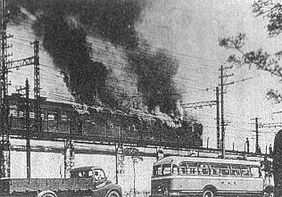Sakuragichō train fire
| Sakuragichō train fire | |
|---|---|
|
The first carriage on fire | |
| Details | |
| Date | April 24, 1951 |
| Time | 13:42 |
| Location | Sakuragichō Station |
| Country | Japan |
| Rail line | Keihin Line |
| Operator | Japanese National Railways |
| Type of incident | Fire |
| Cause | Overhead wire maintenance error |
| Statistics | |
| Trains | 1 |
| Deaths | 106 |
| Injuries | 92 |
The Sakuragichō train fire (桜木町事故 Sakuragichō jiko) occurred on April 24, 1951, when a 63 series Keihin Line (now part of the Negishi Line) train approaching Sakuragichō Station in Yokohama hit a loose overhead wire causing a short circuit and starting a fire which killed 106 people and injured 92.[1]
Accident
On the day in question, maintenance crews were renewing the electrical insulators of the overhead wires when at 13:38 a hanging wire (from which the contact wire is suspended) was accidentally cut allowing the contact wire to hang down. Four minutes later a 5-car MoHa 63 train (1271B) approached from Yokohama station and changed lines 50 metres before Sakuragichō but the pantograph of the leading carriage became tangled in the hanging contact wire. The driver attempted to lower the pantograph, but it fell sideways and hit the wooden carriage, causing sparks which started a fire on the roof which rapidly spread to the rest of the carriage.
The 150 people travelling in the carriage were unable to open the electrically operated doors. The connecting door to the second carriage only opened inwards, impossible with the crowd of panicking passengers inside. Finally, the windows of the carriage were too small to escape through: 63 series cars, of wartime design, employed many cost-cutting measures, one of which was a three-pane window design, where only lower and upper panes could be opened. Intended to escape an expense of a large, full-sized glass pane, this design left the openings too small to pass through. The passengers were therefore trapped; the first car, constructed soon after World War II of combustible materials (another cost-cutting measure was the wooden roof of these cars), was completely consumed by fire within ten minutes, killing 106 people and injuring 92 more.
Response
The investigation report resulted in improved fire-proofing of all such carriages and the provision of through-corridors between carriages. Although the electrically-operated doors had manual overrides positioned under the passenger seats, this was poorly signed. The report resulted in their being marked with red signage.
This accident also caused the resignation of Hideo Shima, director of the railway's rolling stock department, in 1951. Shima was later employed with Japanese National Railways in 1955 to design and build Japan's first "bullet train" (Shinkansen).[2]
A monument to the accident victims was subsequently built at Sōji-ji in Tsurumi-ku, Yokohama.[3]
References
- ↑ Saito, Masao. "Japanese Railway Safety and the Technology of the Day". Japan Railway & Transport Review (33): 4–13. Retrieved August 3, 2008.
- ↑ Salpukas, Aigis (March 20, 1998). "Hideo Shima, a Designer of Japan's Bullet Train, Is Dead at 96". New York Times. Retrieved September 21, 2010.
- ↑ 林正己. 大本山總持寺境内にある鉄道事故関係慰霊碑等について (in Japanese). Retrieved December 16, 2012.
Source
| ||||||||||
Coordinates: 35°27′12″N 139°37′44″E / 35.45333°N 139.62889°E
